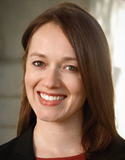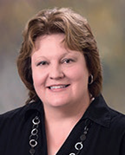The benefits of being a rural nurse practitioner
 Hannah Neprash, PhD  Michele Reisinger, DNP, APRN, FNP-C |
To keep up with the demands of practice, nurse practitioners (NP) have to wear many hats. Fortunately, those serving rural areas are afforded more autonomy in their work than urban NPs, a recent study shows.
“In addition to providing primary care for a wide range of patients, NPs may have extended care rounds for complex cases and emergency department calls,” says Michele Reisinger, DNP, APRN, FNP-C, Washburn University assistant professor of doctoral nursing. “They need to have a skill set that enables them to care for someone with acute chest pain — and if there’s not an advanced life support crew available, they may need to ride on the ambulance to provide care for a critically ill patient. Increased autonomy is something you gain as you practice and it is associated with becoming a proficient practitioner.”
The NP profession continues to grow rapidly, outpacing doctors in rural areas. Nearly half of all rural primary care practices employ at least one NP, driven by demand for health care and an aging rural population. As the number of NPs increases in underserved rural areas, the role of NPs has expanded as well. Recent research has examined the autonomy of NPs practicing in rural and urban settings, and the findings support the need for education and training to prepare NPs for the demands of rural practice.
Measuring practice autonomy
A study on NP autonomy published in Medical Care Research and Review in July was led by Hannah Neprash, PhD, University of Minnesota Division of Health Policy and Management assistant professor, in collaboration with several NRHA members within the University of Minnesota Rural Health Research Center. Neprash and her team were able to measure NP practice autonomy by examining three aspects of independence:
- The percentage of patients treated exclusively by NPs.
- The independence of NPs from physician supervision, measured in terms of how services were billed.
- The authority of NPs to prescribe a range of medications including controlled substances.
The researchers analyzed data from a combination of all-payer insurance claims and electronic health record data from athenahealth, Inc., a health care information technology company. “Electronic health record data gave us a window into how a primary care practice works, including what the physicians do and what NPs do in rural and urban practice,” Neprash says. “Through our research, we found a pronounced and striking pattern. In all the ways we could measure clinical autonomy, NPs in rural areas had more autonomy than NPs in urban areas.”
The research team studied 2,590 primary care practices and found:
- 10.8 percent more patients in rural primary care practices were seen exclusively by NPs (rather than physicians) compared with urban practices.
- Rural NPs were 14.9 to 34.8 percent more likely to practice without direct supervision from physicians than urban NPs (such as billing independently or seeing patients when physicians weren’t in the office).
- Rural NPs were 9.6 percent more likely to prescribe schedule II controlled substances such as opioids compared with urban NPs.
- Rural and urban NPs provided similarly complex care.
"Rural NPs are members of the community and well-suited to provide primary care, prevention, and educational services for the communities they live in."
- Michele Reisinger
Preparing NPs for increased autonomy
Reisinger has been an NP for more than 20 years and emphasizes the strong need for educational programs to support NPs in rural practice.
“The challenge piece is that autonomy comes with great liability,” Reisinger says. “A rural NP may be 30 miles from a supervising physician or 30 miles or more from a hospital providing a higher level of care. A supervising physician may be available by phone only or in the office for a half day every other week, which means NPs must practice with autonomy out of necessity in many cases.”
In her role with Washburn University, Reisinger has helped facilitate an advanced educational nursing workforce grant centered on educating nurse practitioners for rural practice. “The purpose of the grant is to give these NPs valuable experiences so they can encounter what it is like to practice in rural areas and build the skills needed to prepare them to do that,” Reisinger explains.
Insights on rural practice
Although increased practice autonomy can be a burden for NPs practicing in rural areas without having another provider to fall back on, it may also be one of the reasons NPs enjoy their work.
“Surveys of NPs in the past suggest a strong relationship between autonomy and job satisfaction, which may be a factor in NPs staying on the job. The decision to move to a rural location is a complicated one with many factors, and practice autonomy may be appealing to those who want to use the full extent of their training,” Neprash says.
Looking ahead, the possibilities for the profession continue to grow. NPs are in high demand in rural areas and positioned to provide a full spectrum of care to a changing rural population.
“The success of NPs in rural areas is tied to the support we provide nurses going into the profession and continuing their skills,” Reisinger says. “We’re seeing a lot of focus on models based on hands-on learning as well as mentoring programs for rural NPs to assist with the transitional role into rural practice.”
This study was supported by the Federal Office of Rural Health Policy, Health Resources and Service Administration, U.S. Department of Health and Human Services, and the Robert Wood Johnson Foundation.
